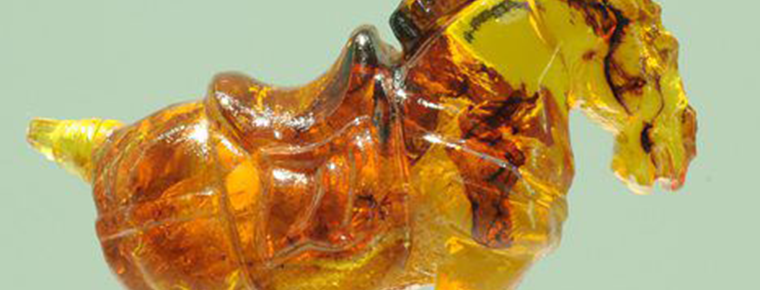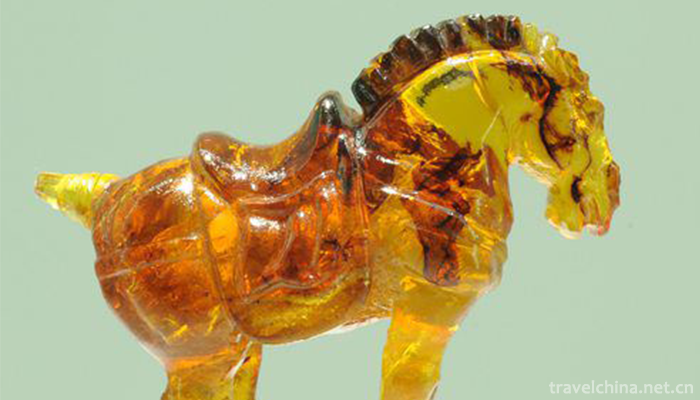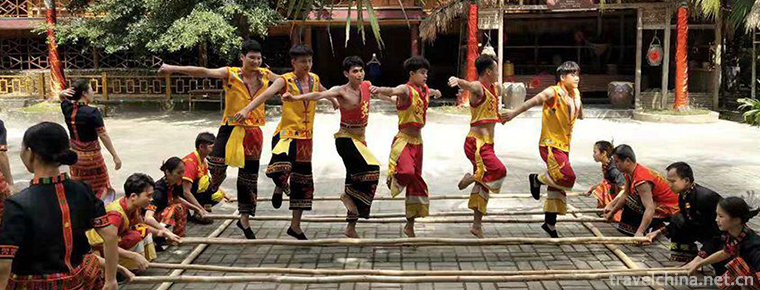2019-05-12

- By ChinaWiki.net
- Chinese Edition
- 2019-05-03
Amber carving
Fushun Amber, a special product of Fushun City, Liaoning Province, is a national geographical indication product of China.
Amber is the secretion of prehistoric plants, buried underground, and formed by high temperature and pressure. It is called resin fossil or resin fossil. Its refractive index is 1.54 and hardness is 3. It is easy to process and make various craft carvings.
Fushun is one of the most famous amber producing areas in the world and the only producing area of Chinese insect amber. Fushun amber was formed in the early Eocene of Old Tertiary, more than 50 million years ago, more than 30 million years earlier than Baltic amber. It is a unique mineral resource of Fushun West Open-pit Coal Mine. It is rich in variety, tough in texture, brilliant in color and rare in output. It is mainly used to make carving crafts and jewelry.
On September 02, 2014, the former General Administration of Quality Supervision and Inspection approved the implementation of the protection of geographical indication products for "Fushun Amber".
historical origin
Fushun amber was produced in Fushun West Open-pit Coal Mine. In 1901, Wang Chengyao, then the national capitalist, was licensed to start trial mining. In 1903, the amber and coal concentrate were mined with coal. Zhao Kunsheng and Zhao Jinglin, Wang Chengyao's Hebei compatriots, are brothers. They work as woodworkers in mines and specialize in woodcarving. They used their own woodcarving skills to carve coal concentrate amber. They found that they were the raw materials of strong carvability crafts. They switched to specializing in coal concentrate amber carving.
During the three years of the Republic of China (1914), the Fushun West Open-pit Mine was converted to open-pit mining, and a large number of amber was mined. The brothers thought that the business prospects were very good. They cooperated with another woodcarving artist, Zhang Baixiao, to establish the first business name "Shuanghe Xing", which specializes in coal concentrate, amber sculpture and sales. Business is booming. Zhao Kunsheng is a big shopkeeper. He works with Zhang Baixiao in sculpture production. Zhao Jinglin spends part of his time in sculpture production, and is also responsible for sales in Fengtian (Shenyang), Lushun (Dalian) and Guangzhou. "Shuanghe Xing" recruited and trained more than 20 apprentices. It was the largest coal refined amber sculpture workshop at that time ("Hundred Years of Coal Sculpture"). Three of them also became masters of the generation of amber sculpture in Fushun in the 1930s. The scale of coal refined and amber sculpture in Fushun developed greatly. Besides "Shuanghe Xing", Baoju Amber, Jinsheng Amber and Datian Amber also came into being. Xiu. According to Fushun County Chronicle of the Republic of China, "20 workshops of Carboniferous (coal essence) and coal jar (amber) utensils" and Fushun's coal essence and amber carving industry have formed a certain scale. During this period, Guo Baoju, Bai Jinsheng and Yuan Datian, the second generation amber artists "Baoju Amber", "Jinsheng Amber" and "Datian Amber", are representative figures. During this period, amber carving production started from the following period. Coal sculpture is independent, but most of them operate at the same time with gold and silver production.
As early as 20 years of the Republic of China (1931), Chinese paleontologist Bingzhi began to study Fushun amber. However, due to the outbreak of the September 18th Incident, the study of amber in China was interrupted. After Japan invaded China, a large number of open-pit mining of amber in Fushun was carried out. Japanese scholars collected samples of amber. By the 1970s and 1980s, relevant experts had collected them.
Product honor
In 2008, Fushun amber carving technology was listed in the list of intangible cultural heritage protection in Liaoning Province.
On September 02, 2014, the former General Administration of Quality Supervision and Inspection approved the implementation of the protection of geographical indication products for "Fushun Amber".

Ask a Question
Your email address will not be published.



0 Questions